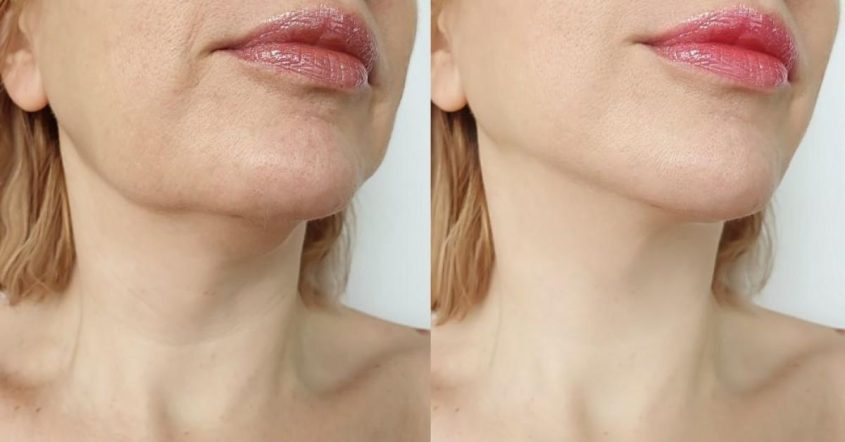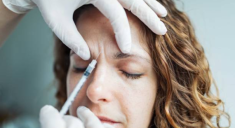Jowls are the loose, sagging skin that appears along the jawline as we age. They develop when the skin loses its firmness and elasticity, causing it to droop. This happens because, over time, our body produces less collagen and elastin—two essential proteins that keep skin tight and youthful.
Several factors can make jowls worse, including genetics, weight changes, sun exposure, and lifestyle habits like smoking or poor posture. While aging is a natural process, understanding what causes jowls can help you take steps to prevent or reduce them.
Knowing how to prevent jowls through skincare, a healthy lifestyle, and good posture can slow down sagging. If jowls have already formed, various treatments—from skincare products to medical procedures—can help restore a more defined jawline. This guide will explain the causes, prevention tips, and the best treatment options to help you keep your skin looking firm and youthful.
What Are Jowls?
Jowls are the loose, sagging skin that forms along the jawline and lower cheeks. As we age, our skin loses collagen and elastin, which help keep it firm and tight. This causes the skin around the jawline to droop, creating jowls.
Jowls can vary in appearance—some people may have mild sagging, while others may notice deeper folds of skin. They can make the face look older and less defined, affecting the sharpness of the jawline. In some cases, jowls can also create shadows on the lower face, making the skin look less smooth.
While jowls are a natural part of aging, they can develop earlier due to factors like genetics, sun damage, weight changes, or poor posture. Many people seek ways to prevent or treat jowls to maintain a more youthful and sculpted facial appearance.
Causes of Jowls
Jowls develop over time due to several factors that affect the skin’s strength and elasticity. While aging is the most common cause, other elements like genetics, lifestyle habits, and environmental factors can speed up the process.
One of the main reasons jowls form is aging. As we get older, our body naturally produces less collagen and elastin, which are proteins that keep the skin firm and tight. Without enough of these proteins, the skin starts to sag, and gravity pulls it downward, leading to the appearance of jowls. Additionally, the fat and muscle structure in the face also change with age, which can further contribute to loose skin around the jawline.
Genetics also play a big role in how and when jowls develop. Some people inherit facial structures that make them more prone to sagging skin. If your parents or grandparents had noticeable jowls as they aged, there’s a higher chance that you might develop them too. Skin type also matters—people with thinner skin may experience sagging earlier than those with thicker skin.
Weight fluctuations can speed up the formation of jowls. When you gain weight, excess fat can accumulate in the face, making the skin stretch. If you lose weight quickly, that stretched skin may not shrink back completely, leading to sagging. This is especially noticeable in people who have lost a significant amount of weight, as the skin around the jawline and cheeks may not be able to tighten fully.
Sun damage is another major factor that can contribute to early jowl formation. The sun’s ultraviolet (UV) rays break down collagen in the skin, leading to premature aging. Over time, prolonged sun exposure weakens the skin’s structure, making it more likely to sag. This is why people who spend a lot of time in the sun without proper protection often develop wrinkles and loose skin earlier in life.
Certain lifestyle habits can also make jowls worse. Smoking, for example, reduces blood flow to the skin and damages collagen, leading to early sagging. A poor diet that lacks essential nutrients can weaken skin health, while dehydration makes the skin less plump and elastic. Not taking care of your skin—such as skipping moisturizer or not using sunscreen—can also contribute to premature aging and sagging.
Another often-overlooked cause of jowls is poor posture, particularly looking down at phones or computers for long periods. This is sometimes called “tech neck.” Constantly bending your neck forward can weaken the muscles that support the jawline, leading to loose skin over time. Keeping good posture and avoiding excessive screen time can help maintain the skin’s firmness.
While some of these causes are unavoidable, like aging and genetics, others can be managed with the right lifestyle choices and skincare routines. Understanding what leads to jowls can help you take steps to slow down their development and keep your skin looking firmer for longer.
How to Prevent Jowls
While jowls are a natural part of aging, there are many ways to slow their development and keep your skin firm for longer. Taking care of your skin, maintaining a healthy lifestyle, and being mindful of daily habits can make a big difference.
One of the most effective ways to prevent jowls is by following a good skincare routine. Keeping your skin hydrated with a quality moisturizer helps maintain elasticity and prevents dryness, which can make sagging more noticeable. Sunscreen is essential because the sun’s UV rays break down collagen, leading to premature aging and loose skin. Using a broad-spectrum sunscreen with at least SPF 30 every day can protect your skin from damage. Retinol, a form of vitamin A, is another powerful skincare ingredient that helps boost collagen production. Regular use of retinol-based creams or serums can keep the skin firmer and delay the formation of jowls.
A healthy diet and proper hydration also play a major role in preventing sagging skin. Eating foods rich in vitamins and antioxidants helps support collagen production. Vitamin C, found in citrus fruits, berries, and bell peppers, is essential for collagen formation, while vitamin E, found in nuts and seeds, protects the skin from damage. Protein-rich foods like eggs, fish, and lean meats provide the building blocks needed for strong and healthy skin. Drinking plenty of water is just as important because dehydration can make the skin appear thinner and less elastic. Staying hydrated keeps the skin plump and slows down sagging.
Regular exercise and facial yoga can help keep the jawline defined and prevent jowls from forming too soon. Just like muscles in the body, the muscles in the face can be strengthened to maintain a firm structure. Simple facial exercises, such as tilting your head back and stretching your neck, or pressing your tongue against the roof of your mouth while smiling, can help tone the muscles around the jawline. General physical exercise also improves blood circulation, which helps nourish the skin and keeps it looking youthful.
Maintaining good posture is another simple yet effective way to prevent jowls. Many people spend hours looking down at their phones or working on computers, which weakens the muscles in the neck and jawline over time. This condition, often called “tech neck,” can contribute to sagging skin. Keeping your head level, sitting upright, and adjusting your screen to eye level can help reduce the strain on these muscles and keep the skin from loosening prematurely.
Avoiding harmful habits like smoking, excessive alcohol consumption, and dehydration can also make a big difference. Smoking reduces blood flow to the skin and breaks down collagen, making the skin lose its firmness much faster. Alcohol can dehydrate the body and skin, leading to a tired and sagging appearance. Drinking too much alcohol also strips the skin of essential nutrients, making it more prone to wrinkles and jowls. Cutting back on these habits and focusing on hydration and skin-friendly nutrition will help keep your skin firm and youthful for a longer time.
By making these simple lifestyle adjustments and taking care of your skin, you can slow down the development of jowls and maintain a more sculpted and youthful appearance. Even small changes, like using sunscreen daily, drinking more water, or improving your posture, can have long-term benefits in keeping your jawline firm.
Comprehensive Treatment Options for Jowls
If jowls have already formed, there are several treatment options available to improve their appearance. These treatments range from simple skincare routines to advanced medical procedures, depending on how severe the sagging is and the results you want to achieve.
Non-Surgical Treatments
For those looking for non-surgical treatments, skincare products can be a great starting point. Retinoids, which are vitamin A-based creams, help increase collagen production and make the skin firmer over time. Peptides are another powerful ingredient that supports skin repair and elasticity. Collagen-boosting creams containing ingredients like hyaluronic acid and vitamin C can help plump the skin and improve its texture, reducing the appearance of sagging. While skincare products won’t completely remove jowls, they can slow down the aging process and improve overall skin health.
Facial exercises are another non-invasive way to help tone the muscles around the jawline. Just like body workouts strengthen muscles, facial exercises can keep the jaw and cheek muscles firm. Some people find that regularly doing facial yoga or targeted exercises helps tighten the skin and prevent further sagging. However, results can take time, and consistency is key.
For those looking for more noticeable improvements without surgery, ultrasound and radiofrequency treatments are popular options. These treatments use energy waves to heat the deeper layers of the skin, stimulating collagen production and tightening loose skin. They are painless, require little to no downtime, and can gradually lift the jowls over several sessions. While the results are not as dramatic as surgery, they can be a great alternative for people who want a non-invasive approach to skin tightening.
Dermal fillers are another effective way to reduce the appearance of jowls. These are injectable treatments that add volume to areas of the face that have lost firmness. By injecting fillers into the cheeks or jawline, the skin is lifted and reshaped, creating a more defined facial contour. The results are immediate, but they are temporary and usually last between six months to two years, depending on the type of filler used.
Thread lifts are a minimally invasive procedure that involves inserting dissolvable threads under the skin to lift sagging areas. These threads stimulate collagen production and provide an instant lifting effect. The procedure is quick and requires minimal recovery time, making it a popular option for those who want a subtle lift without undergoing surgery. However, thread lifts are not permanent, and the effects usually last between one to two years.
Surgical Treatments
For individuals with severe jowls who want long-lasting results, surgical treatments may be the best option.
Facelift surgery is the most effective way to remove excess skin and tighten the lower face. During this procedure, a surgeon lifts and repositions the skin and underlying tissues to restore a youthful appearance. A facelift provides dramatic and permanent results but requires a longer recovery period.
A neck lift is another surgical option, focusing on tightening the skin around the jawline and neck. This procedure is often done alongside a facelift to enhance definition and create a smoother, more sculpted look. It is particularly beneficial for those who have significant sagging in the neck area along with jowls.
For people with excess fat around the jawline, liposuction can help remove unwanted fat deposits and create a more defined facial shape. This procedure is often combined with other treatments, such as a neck lift or facelift, to achieve the best results. Liposuction alone is most effective for younger individuals whose skin can still tighten naturally after fat removal.
Choosing the Right Treatment
Choosing the right treatment depends on the severity of the jowls, personal preferences, and how much downtime you are willing to take. Non-surgical treatments work well for mild to moderate sagging, while surgical options provide the most dramatic and long-lasting results for severe cases. Consulting with a dermatologist or plastic surgeon can help determine the best approach to achieving a firmer and more youthful jawline.
Final Thoughts
Jowls are a common part of aging, but understanding their causes and taking preventive steps can help keep your skin firm and youthful for longer. Factors like aging, genetics, weight changes, sun exposure, and lifestyle choices all play a role in their development. While jowls cannot always be avoided completely, using good skincare products, maintaining a healthy diet, staying hydrated, and practicing facial exercises can slow down their formation. If jowls have already formed, there are several treatment options to consider. Non-surgical treatments like skincare products, facial exercises, and radiofrequency therapy can help improve skin elasticity and reduce sagging. For more noticeable results, treatments such as dermal fillers and thread lifts can provide temporary lifting effects. In cases of severe sagging, surgical options like facelifts, neck lifts, and liposuction offer long-lasting improvements. The best way to maintain a youthful jawline is to start preventive measures early. Protecting your skin from sun damage, staying hydrated, avoiding harmful habits like smoking, and practicing good posture can all help delay the appearance of jowls. If you’re unsure about the best approach for your skin, consulting a dermatologist or plastic surgeon can provide personalized recommendations based on your needs. Taking care of your skin today can make a big difference in how it looks in the future. Whether through prevention or treatment, there are plenty of ways to keep your skin looking firm, healthy, and youthful.
















